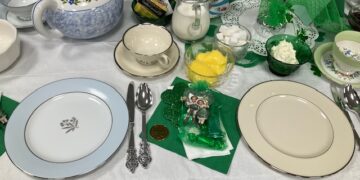Not much happens in the December garden, but this is the time of year we baffle pets and delight children by setting up a tree in the living room. Christmas trees, garland, wreaths, and holiday plants provide ways to bring some life into our homes during an otherwise dormant season. But did you know that many of these plants can be kept year-round?
While most people purchase a cut tree from a local farm or pull a synthetic one out of storage, Paul and I simply move our Christmas tree from the dining room to the living room. It might not have the same charm, but it’s better for the environment and serves as an attractive houseplant during the other 11 months. That’s because our Christmas tree of choice is a potted Norfolk Island pine (Araucaria heterophylla).
You’ve likely seen these lovely little trees in garden centers around the holidays, sprayed with silver glitter to make them look more “festive” (I recommend buying one that hasn’t been glittered). Native to Norfolk Island, an Australian territory in the South Pacific, they are not actually true pines. Rather, Norfolk Island pines belong to a prehistoric family of conifers that went extinct in the northern hemisphere at about the same time dinosaurs did. They grow up to 200 feet tall with 10-foot trunks in the wild, which is hard to believe when the trunks of mine are barely wider than my thumb. In fact, a Norfolk Island pine kept as a houseplant will grow slowly, only reaching five to eight feet in height over ten years. This makes it perfect for cheering up an empty corner or even decorating as a Christmas tree. Just be sure not to overburden its delicate branches; use only lightweight ornaments — and lights, of course!
Being tropical trees, Norfolk Island pines prefer bright, indirect sunlight and moderate to high humidity. They should be watered whenever the top inch of soil feels dry, and turning them every week or so will help keep them from growing lopsided. And that’s about it! Fertilizing is entirely optional and should only happen in the summer, and I don’t recommend pruning, which will only distort the tree. You should, however, repot it every two to three years. Use a slightly larger pot if you want it to keep growing or a similar-sized container to slow it down.
Yet another tropical holiday plant, poinsettias (Euphorbia pulcherrima) are actually woody perennial shrubs from Mexico and Central America. And just like a potted “Christmas tree,” poinsettias can be enjoyed year-round, too! They also thrive in bright, indirect sunlight and should be kept away from drafts. You can keep the decorative wrapper on during the holidays, but make sure to remove it to water the plant when the soil feels dry, thoroughly soaking the soil and allowing any excess water to drain out the bottom before replacing the wrapper.
After the Christmas season, discard the wrapper and place the pot on a saucer. If you like, you can apply an all-purpose houseplant fertilizer once the colorful bracts begin to fade. Around April the plant will likely begin to look leggy, at which point you should cut it back to about six inches high and repot it in a slightly larger container. You can move the poinsettia outside in early summer, then bring it back inside before temperatures dip below 50 F in the fall. Reduce watering around Thanksgiving, and by Christmas, you should have bright, beautiful bracts on your poinsettia again!
Although they’ve developed a bad reputation, poinsettias are actually only mildly toxic to both humans and animals. But if you have exceptionally curious children or pets, you may want to stick with something safer, like a Christmas cactus (Schlumbergera bridgesii or S. x buckleyi). These colorful succulents are also a bit easier to care for.
Christmas cacti are — you guessed it — tropical plants, from Brazil. They share the same light, humidity, and moisture requirements as Norfolk Island pines and poinsettias, though they will tolerate low light. Christmas cacti should be repotted every two to three years in late winter or early spring, after the flowers wilt. To encourage branching and thus more flowers, you can also prune them about a month after the blossoms drop. Pinch off a few sections from each branch, removing up to a third of the entire plant. But don’t throw out those branches! The growing tips propagate easily. Remove the bottom segments from the trimmings so that each cutting is two to four segments long, and lay them out for up to three days to let them heal over. Then place them in moist vermiculite in indirect sunlight and water sparingly for a few weeks, until red new growth appears and the newly rooted cuttings can be watered normally. And just like that, you already have Christmas gifts for next year!
































